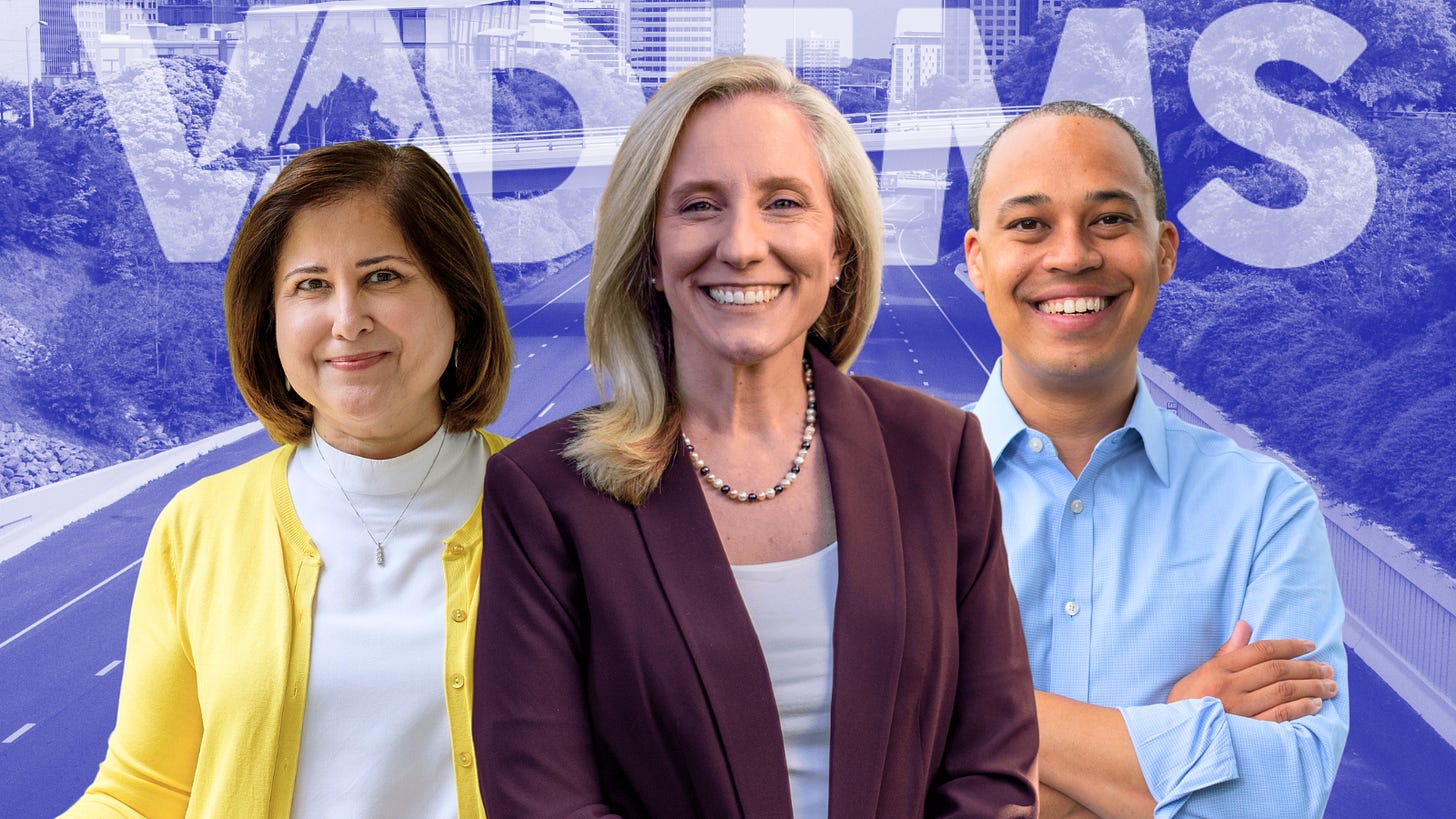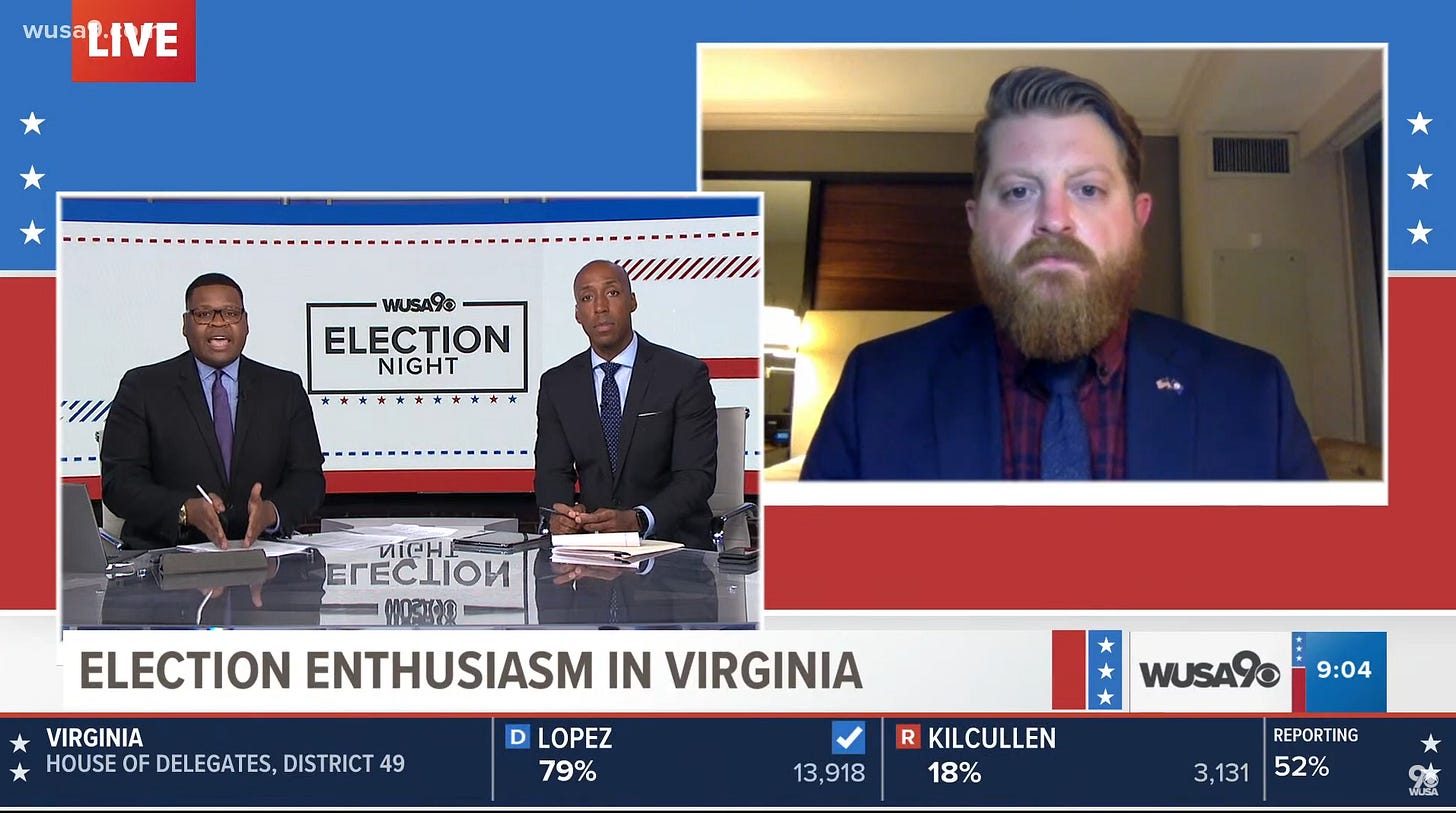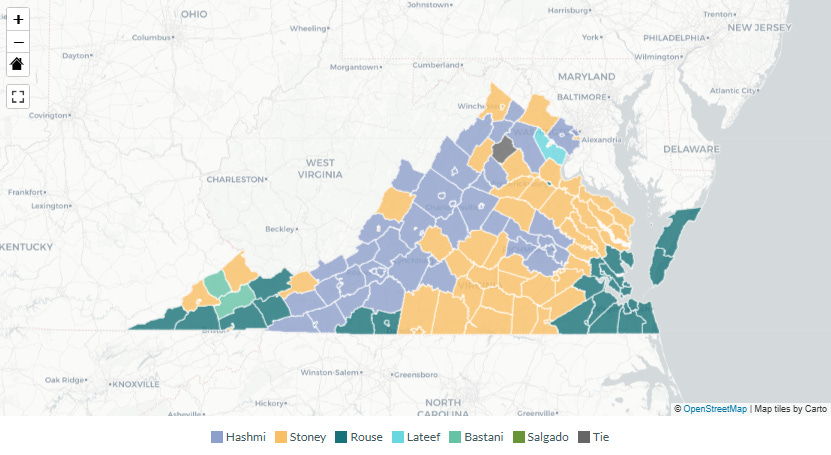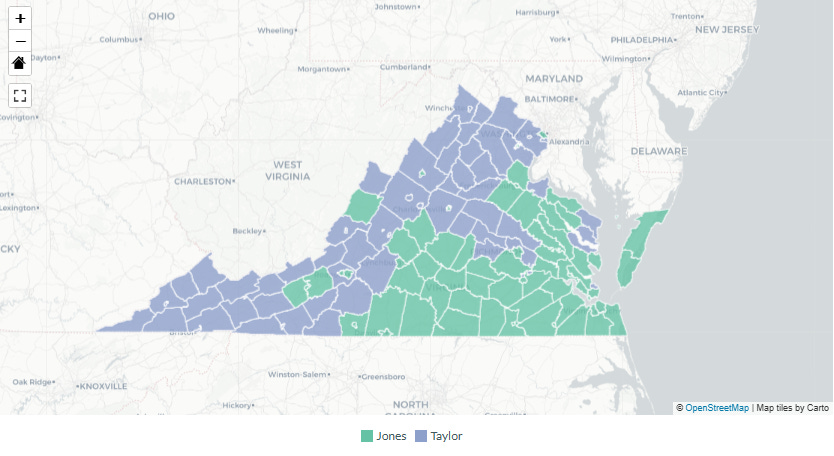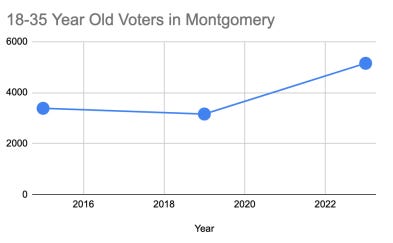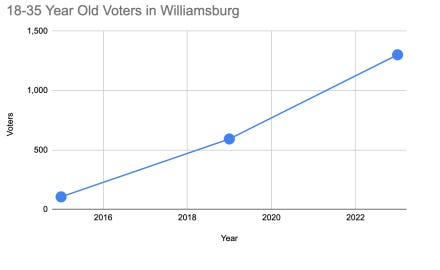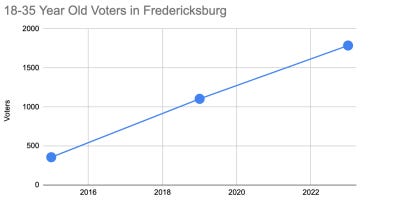The Road to Election Day 2025: A Strategy for Virginia Democrats
Rural Votes, Campus Votes, and the Future of Our Party
Well there you have it, folks—another Virginia Primary has come and gone in the heat of June, and we officially have our Democratic ticket. Joining former Rep. Abigail Spanberger on the statewide ballot are Senator Ghazala Hashmi for Lieutenant Governor and former Delegate Jay Jones for Attorney General—two strong candidates in their own right, each bringing their own style and priorities to the campaign.
Not to be overlooked, we also now have Democratic nominees in every House of Delegates race across the Commonwealth.
Races I’m Watching
Personally, I’ll be keeping a close eye on a few key races:
Flippable seats:
Incumbent protection:
Democrats have a massive opportunity this year to capitalize on the discontent sown by Donald Trump, Elon Musk, DOGE, and Republicans on Capitol Hill. But we must learn from our past mistakes if we’re going to seize it. We all remember the sinking feeling of November 2, 2021. I was at the McAuliffe watch party at the Tysons Corner Hilton, doing media hits while live results I hadn’t yet seen were scrolling beneath me—and doing my best to hold it together.
Over the last four years, Virginia Democrats have proven that we’re capable of delivering and winning again. We held our seats in 2022. We flipped the House back to blue in 2023. In 2024, we sent all our electoral votes to Kamala Harris and held our Senate and House seats despite two retirements. We showed that 2021 was a fluke—and that we’re better organized now. But only if we lean into the lessons of the past four years can we keep moving forward.
Lesson One: Embrace and Unite All Parts of Our Party
After any primary, there will always be a portion of the electorate that feels unheard. That’s especially true in races where the winner doesn’t break 50%, and it’s even harder to ask people to turn around and campaign for someone they just ran against. But if our nominees embrace their former opponents and incorporate some of their policy priorities into their platforms, they’ll find themselves in a much stronger position to unify the party. One thing that absolutely does not work: running to the middle and punching left.
What we can’t afford is a repeat of 2021, when many of former Governor Terry McAuliffe’s supporters used the primary outcome to attack the left, especially voters who had backed Jennifer Carroll Foy, Lee Carter, or Jennifer McClellan. The message from the McAuliffe camp often came across as dismissive: “Your candidate lost, get over it.”
We’re actually in a unique position this cycle with a gubernatorial candidate who didn’t go through a contested primary. That has its advantages, but it also means some voters will feel like they didn’t have a say—just as many did when President Biden stepped aside and Vice President Harris became the nominee. If we’re serious about unity, we need to take those concerns seriously, not belittle or ignore them.
Dismissing people who poured their time, energy, and hope into another candidate is demoralizing. It sends the message that their voices—and their values—don’t matter.
Some point to Bernie voters staying home in 2016 or to low turnout in 2021, blaming sore-loser syndrome. But I don’t think that’s what’s happening. It’s not about spite—it’s about people feeling excluded and unseen. When voters feel like nothing they do matters, they disengage.
Two maps illustrate this divide perfectly:
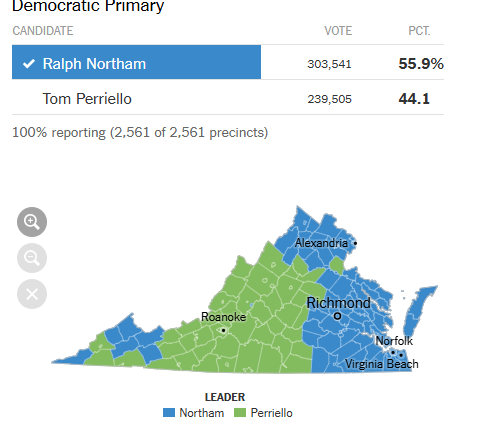
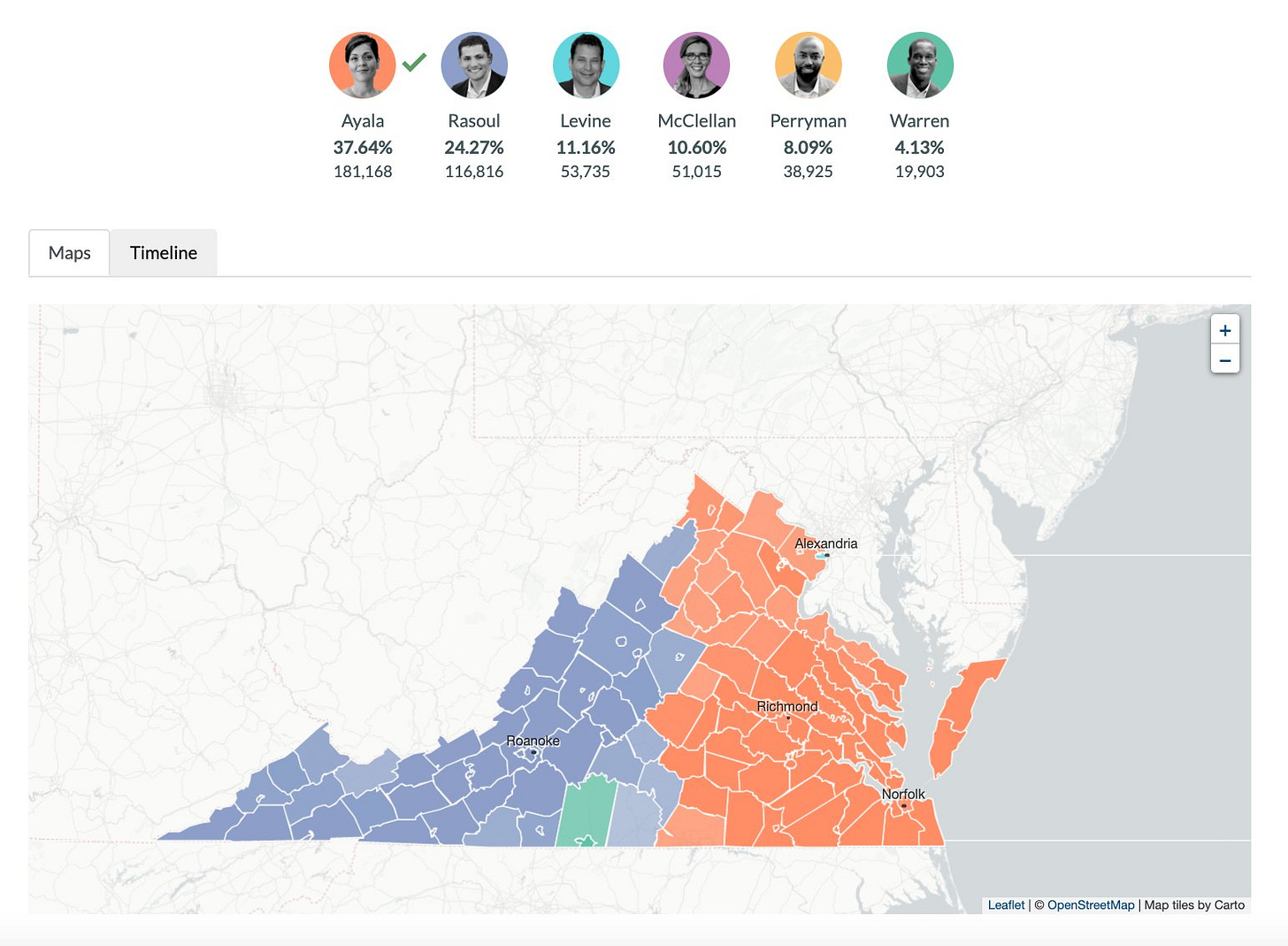
The 2017 Democratic gubernatorial primary between Ralph Northam (blue) and Tom Perriello (green).
The 2021 lieutenant governor primary between Hala Ayala (red) and Sam Rasoul (blue).
In both cases, Virginia split down the middle—urban vs. rural. In 2017, Northam embraced Perriello and unified the party. In 2021, we didn’t see the same level of effort, and it showed.
Last night, we saw similar regional rifts in the two state wide races—especially in the Attorney General’s race with some caveats. Even though the more progressive candidates won, we still would benefit from examining what effects these divides.
Candidates this year should follow Northam’s example. Embrace your former rivals. Integrate their ideas—whether it’s about casino referendums, federal job losses, campaign finance reform, or local development. Voters across the Commonwealth need to see that their concerns are being heard.
We are in this fight together. The Republicans—especially Winsome Sears—want to divide us before November. Let’s not help them do it.
Lesson Two: Every Single Vote Counts—Especially Beyond NoVA and RVA
Credit where credit is due: Team Spanberger is doing this part right. They’ve already visited Southwest Virginia, Hampton Roads, and other regions often neglected by statewide campaigns. They’re even planning a commonwealth-wide bus tour from June 21–28. That’s a huge improvement from 2021.
Back then, McAuliffe’s campaign largely focused on Northern Virginia and the Metro Richmond Area. That’s where we’re strongest—but not where we need the biggest lift. Trips to Hampton Roads were limited, and the I-81 corridor was barely touched. Unsurprisingly, Democratic turnout in those areas suffered.
We can’t make that mistake again.
Fortunately, we’re not in this alone. Groups like Rural GroundGame are already doing vital work to engage and mobilize voters in places many campaigns overlook. Since 2019, they’ve used tactics that actually resonate in rural areas—highway billboards, linear radio, and community-driven storytelling. And it works.
In 2019, RGG-supported candidates saw turnout boosts of 11 points—compared to 3 points elsewhere. In 2021, even as we lost statewide, their candidates outperformed the top of the ticket. They’ve kept that momentum through 2023 and used infrastructure funding awareness campaigns to make Biden’s wins visible in rural Virginia.
We should be investing in them in 2025. (You can chip in here.)
Once again, I applaud the Spanberger campaign for learning the right lessons. They’re following the playbook of Senator Tim Kaine and Senator Mark Warner—leaders who know rural voters matter. We lost in 2021 by just 1.9%. A few more trips and a little more investment in rural organizing could’ve made the difference.
Let’s not leave any region behind. Let’s not repeat the mistakes of 2021. If we want to win in 2025, we need to show every Virginian that they matter. Because they do.
Invest in College Campus Organizing—Early and Often
In July 2023, Politico published “How College Towns Are Decimating the GOP,” where Charlie Mahtesian and Madi Alexander detailed how Democrats have gained momentum in local and state elections thanks to higher turnout from college students—even in traditionally Republican strongholds.
Out of 171 college towns they tracked:
38 flipped from red to blue since the 2000 presidential election.
Just 7 flipped from blue to red, and usually by smaller margins.
Democratic vote margins grew in 117 counties, while only 54 became redder.
In raw numbers, counties that trended blue increased their margins by an average of 16,253 votes, compared to 4,063 votes in red-trending counties.
Recognizing this trend, the Virginia Young Democrats made a strategic decision in 2023: invest in organizing on college campuses and help students register to vote where they live. We printed and distributed hundreds of voter registration pamphlets to college chapters in battleground districts, encouraging students to register at their campus address and take advantage of Same-Day Registration.
We also invested significantly in digital ads targeting college students with the same message—and we weren’t alone. The DNC Youth Coordination Team joined efforts at Virginia Tech, University of Mary Washington, and William & Mary. Youth-focused PACs like Leaders We Deserve traveled to key districts, including those of Nadarius Clark and Lily Franklin, to help turn out the vote.
After the 2023 election, I compiled a report for the Virginia Young Democrats analyzing the impact of young voters in competitive districts. The results were clear: college students drove turnout—and in some cases, they were the deciding factor.
HD-41: Lily Franklin (Montgomery County / Virginia Tech)
Young Democrat Lily Franklin ran in HD-41 against Republican Chris Obenshain, ultimately losing by just 183 votes (0.74%) out of 24,875 cast. The district includes Virginia Tech and its off-campus housing—an area where student organizing played a major role despite limited funding.
Votes from 18–35-year-olds in Montgomery County:
2015: 3,386 votes
2019: 3,162 votes
2023: 5,150 votes
That’s a 52% increase over 2015 and a 62% increase over 2019. With more investment, this district could easily flip in 2025 with that.
SD-24: Monty Mason (Williamsburg / William & Mary)
Incumbent Senator Monty Mason lost to Republican Danny Diggs by 725 votes (1.08%) out of 67,179 cast. But just like in HD-41, a campus-driven turnout boom made a difference.
Votes from 18–35-year-olds in Williamsburg:
2015: 106 votes
2019: 593 votes
2023: 1,301 votes
That’s a 459% increase over 2015 and a 119% increase over 2019. With more resources, that 725-vote gap can absolutely be closed this year to help in HD-71.
HD-65: Joshua Cole (Fredericksburg / University of Mary Washington)
Young Dem and former Delegate Joshua Cole ran to reclaim his seat, winning against Republican Lee Peters by 1,750 votes (6.00%).
Votes from 18–35-year-olds in Fredericksburg:
2015: 356 votes
2019: 1,104 votes
2023: 1,787 votes
That’s a 210% increase since 2015 and a 62% increase since 2019. Put simply, Josh Cole won because of the youth vote and can ensure him a win again.
These are just three examples of how student organizing helped flip the House and protect the Senate in 2023, and could have done more.
Imagine what we could do if we started earlier and invested even more.
The Path Forward: Register Students On Campus
College students are counted in population data whether they’re registered or not—but when they do register and vote, the results speak for themselves. It’s time to prioritize on-campus registration drives and give College Democrats chapters the resources they need early in the cycle.
Key districts that will benefit from strong college turnout in 2025 include:
HD-41 (Virginia Tech / Radford University)
HD-65 (University of Mary Washington)
HD-84 / HD-97 (ODU / Norfolk State)
HD-82 (Virginia State University)
HD-71 (William & Mary)
This strategy works. We just have to put our money where our mouth is.
A Message That’s Bigger Than Trump
Finally, it doesn’t matter how we’re talking to voters if what we’re saying doesn’t resonate. Since 2020, we’ve seen the limits of relying too heavily on negative messaging about Trump. We lost when we leaned on fear alone—and we won when we told voters what we stood for.
Yes, Trump is dangerous. Yes, Republican leaders like Winsome Sears are cheering on job losses for Virginians while billionaires rig the economy in their favor. But our message can’t stop there.
We need to speak to the real, day-to-day concerns of Virginians:
Can I pay my bills?
Can I feed my family?
Can I afford to stay in the place I call home?
Can I educate my kids and get to work on time?
We are the party that believes in freedom, dignity, and opportunity for all people. We don’t tell you how to live your life—we fight to make sure you can live it. That’s what’s at stake in 2025.
TL;DR: To win Virginia in 2025, Dems need action.
Unite the party early. Embrace primary opponents and their voters. Don’t punch left and alienate our base.
Invest in rural organizing. Groups like Rural GroundGame are doing the work—fund it.
Don’t just campaign in NoVA & RVA. Go to Hampton Roads, the I-81 corridor, and beyond.
Engage young voters year-round. Get to Campuses Early on in the school year before move in. Don’t wait until October. to show up.
Give people something to vote for. We are the party that believes the American Dream is still achievable for all. Act like it.
We lost 2021 by 1.9%. That doesn’t have to happen again.
Let’s Win in November
Now is the time to come together around our candidates and build a coalition that can win up and down the ballot. Remind Virginia what these Republicans have done—and then give people something to vote for.
Let’s start in overlooked communities.
Let’s start on college campuses.
Let’s start now.
Let’s go to work.



